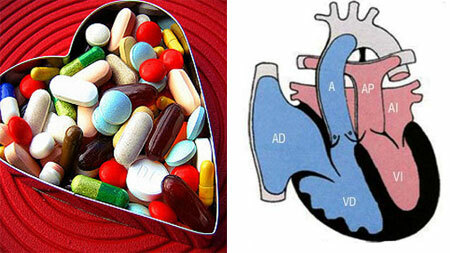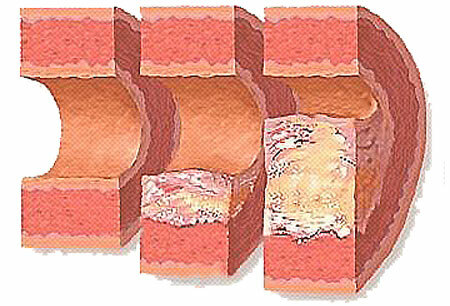What is thrombophlebitis? Inflammatory reactions in the venous walls, accompanied by the formation of blood clots in their lumens, was received in medicine as thrombophlebitis( thrombosis).In 90% of cases, the leg vessels are affected - the superficial and deep venous nets and the perforating veins that connect them.
As a closely related disease, it can be noted - phlebothrombosis, characterized by the same signs( thrombi in the venous cavity), but without the influence of inflammatory reactions. Such a disease is not characterized by a prolonged course, because any vascular pathology always ends with inflammation and the development of thrombophlebitis.
The most common pathology is manifested by thrombosis of superficial subcutaneous veins, which develops accompanied by varicose veins or CVI syndrome( venous outflow disturbance).In this case, the disease often recurs, progresses, is fraught with various complications.
Contents
- 1 Etiology: causes and conditions of thrombophlebitis development
- 2 Types of thrombophlebitis
- 3 First signs of thrombophlebitis, photo
- 4 Symptoms of thrombophlebitis, clinical picture
- 5 Diagnosis and treatment of thrombophlebitis
Etiology: causes and conditions of thrombophlebitis
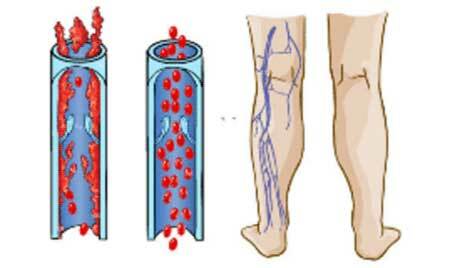
Until the middle of the last century, the formation of blood clots inside the vessels was an absolute mystery. Why, the same blood, in some cases runs through the vessels unhindered, in others - clogs their lumen with clots?
Famous German physician, Rudolf Vikhrov, working in the Berlin Charité clinic, was studying various mechanisms that affect the change in the structure of plasma elements and the identification of the prerequisites for the development of thromboses.
He singled out the main components of the development of the disease, remaining in the practice of modern medicine under the definition of the triad of Vihrov( Trias). Its component is due to:
1. Changing the vascular structure, directly internal lining of the
vessels An important factor is any destructive changes in the internal vascular membrane including traumatic effects. It was noted that the accumulation of blood clots always occurs in areas of apparent structural changes in the vascular walls. The initially smooth, healthy surface of the endothelium acquires roughness in painful and damaged areas.
Small blood clots, passing by, are fixed on a rough surface and settle on the wall of the vessel. The clots accumulate, intertwine, forming a thrombus completely overlapping the vascular lumen. Pathological changes in the endothelium can cause a variety of reasons:
- inflammation of the venous walls( phlebitis);
- inflammatory reactions, affecting the arteries( arteritis);
- inflammation in the cardiac structure( endocarditis).
Promote destructive changes in the epithelial intravascular layer, microorganisms of various infections. Due to the ingestion of a huge toxic mass into the blood plasma, the possibility of clot formation increases sharply, which may well lead to the development of thrombophlebitis
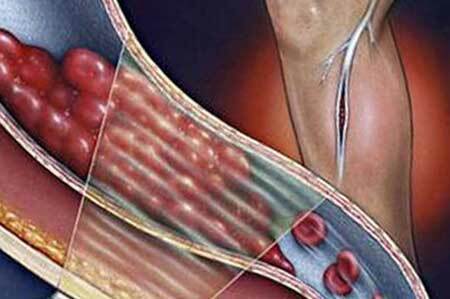
thrombophlebitis, photo
2. The change in the blood flow velocity
Dr. Vikhrov established: the most frequent places in vascular beds where clots formuneven flow of blood plasma and change in its speed. For example, the current in the central part of the lumen is fast, and along the edges of the vessel the course slows down, forming vortices.
This feature of the blood flow is characteristic in the areas of narrowed, or enlarged zones of the vascular bed. What can be a consequence of an aneurysm or varicose veins. The most predisposed to the formation of thrombosis - the place of vascular branching, where the swirl of blood flow is frequent.
Infringement of speed of a blood flow promote:
- injuries of the lower limbs, which result in squeezing the squeezing soft or plaster bandages;
- prolonged limb immobility;
- congestion of blood in cardiac pathologies due to the failure of pumping the full volume of blood;
- systemic and vascular diseases affecting the process of blood flow.
3. Hypervisual syndrome( dense blood)
Another reason for thrombophlebitis of the lower extremities Vikhrov called "dense blood".Today there is no such term in medicine, it is said about the level of its viscosity. Standard standards do not exist, for each of us, the viscosity level is different. But, there are circumstances when in one patient the viscosity of blood plasma in different vascular sites is different.
The main cause of thrombophlebitis is an abnormal fluid loss caused by insufficient intake or excess secretion: severe sweating, heavy loads causing thirst, or diseases accompanied by fever. In addition, the development of thrombophlebitis is influenced by the plasma factors of the anticoagulant and coagulation system.
Under absolutely identical circumstances, the level of hypercoagulability( coagulability) can show different indicators - very high, elevated or decreased, each case is due to - special properties of hematopoiesis, metabolic processes, lack of a specific protein tightening the plasma clotting process( sometimes thiscongenital defect).
A common cause of thrombophlebitis development, blood with hemostasis disorder( dissolution of thrombi).Disorders of hemostasis are facilitated by:
- infectious diseases;
- hormonal dysfunction;
- oncological diseases.
Types of thrombophlebitis
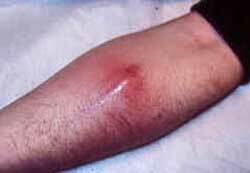 By nature, thrombophlebitis are infectious and non-infectious( aseptic).Which in turn are manifested by different species.
By nature, thrombophlebitis are infectious and non-infectious( aseptic).Which in turn are manifested by different species.
The infectious form of is manifested:
- Postpartum or postoperative thrombosis;
- As a consequence of purulent-inflammatory pathologies( phlegmon, furuncles, erysipelas);
- For infectious diseases( typhus, influenza, tuberculosis).
Non-infectious ( aseptic) form:
- Thrombophlebitis of varicose veins;
- Migrating thrombosis;
- Post-traumatic;
- Thrombotic formation, due to vascular and cardiac diseases.
By the nature of the clinical picture - acute thrombophlebitis and a form of chronic course.
The area of manifestation( localization) is a lesion of the superficial and deep veins network on the limbs, the form of the ileum-femoral lesion
The first signs of thrombophlebitis, photo
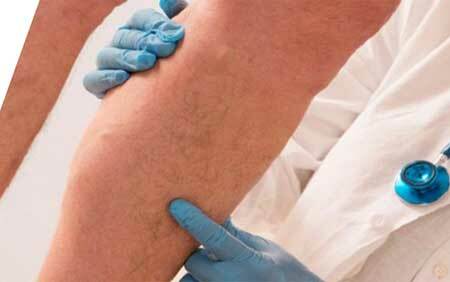
of the manifestation of thrombophlebitis, photo
The onset of the disease can appear unexpectedly - with excellent health, the first signs of thrombophlebitis quickly form.
- Painful syndrome during movement;
- Subfebrile fever and general malaise;
- Puffiness in clot formation - the closer the thrombus is located to the groin, the more puffiness becomes;
- With palpation, the density and tenderness of the veins is noted;
- Skin above the affected area is red with a cyanotic shade, edematous and warm;
- Strengthening of puffiness testifies to the defeat of deep veins.
If at this stage in time not to begin treatment, inflammatory reactions quickly spread along the vascular bed, significantly worsening the patient's condition.
It should be noted that there are thromboses related to "mute" forms, which are not manifested at all by any symptoms. Deterioration of the patient's condition occurs after the fact - when the thrombus completely blocks the vascular lumen.
Symptoms of thrombophlebitis, clinical picture

The pattern of clinical manifestation of the disease mainly depends on the location of the thrombus, the prevalence of the inflammatory reaction, the level of damage to surrounding tissues.
Symptoms of hitting the subcutaneous veins
Already existing large nodular varicose veins aggravate the situation, manifested by structural changes in the vascular walls. The nodes are susceptible to soldering to the skin, injuries and brushes, which causes trophic changes in the skin that promote easy infection. As a result of which inflammatory processes are formed and thrombophlebitis of superficial veins develops. Symptomatics is characterized by:
- restriction of the prevalence of the inflammatory process with local localization of thrombosis;
- a rare deterioration in the general condition;
- change in the structure of the subcutaneous veins - soreness and tightness in the form of cords;
- by immobility caused by an adhesive process between them;
- inflammatory processes of subcutaneous tissue and skin;
- sealed hyperemic skin with a glossy tint.
The venous network of the thigh and lower leg are most affected. There is a prevalence of swelling in the ankle and an increase in inguinal lymph nodes. Usually the general condition is not disturbed, the soreness in movement is moderate, does not prevent the patient from working.
In advanced cases, the spread of inflammatory reactions aggravates the symptoms of thrombophlebitis. There is a sharp increase in pain and an increase in temperature to high rates. Preservation of acute symptoms can last up to a month and a half.
Special attention should be paid to subcutaneous migratory thrombosis. The nature of the disease is due to the formation of a large number of thrombotic clots in the subcutaneous vessels. Symptomatics is characterized by moderate manifestation without disturbing the general state of health.
The positive aspect is due to the absence of any trophic changes or traces. After a certain time, the inflammatory reaction migrates to another zone of the limbs, which fully justifies the name of the disease.
Signs of affection of the deep vein network

Development of such pathology is typical for bone fractured regions of the thighs or lower leg, the treatment of which was performed by operating procedures. Or for abdominal operations and surgical treatment of chest pathologies. The formation of thrombosis contributes to the increase in the coagulation factor necessary to prevent bleeding during surgery.
Symptoms of thrombophlebitis when localized in a deep venous system are manifested:
- severity and fatigue of the legs, a feeling of raspiraniya;
- strongly pronounced edema and soreness of the legs;
- cyanotic skin coloration;
- with acute impairment of pulmonary circulation( sometimes the first symptom);
- febrile fever and glossy skin;
- by a painful intraarticular syndrome;
- by changing local temperature( cold limb);
- is sometimes a sign of peritonitis and functional intestinal obstruction.
In the background of the disease( varicosity), there are frequent relapses each time exacerbating trophic changes in tissues and disturbance of the circulatory system. If there are obvious symptoms of thrombophlebitis, treatment should not be postponed to a "long box".
The main threat - purulent complications in the form of phlegmon, abscess or sepsis. And also the development of thromboembolism. Exodus can be expressed in two variants - obstruction of small blood vessels or occlusion of vital arteries, which leads to mortality.
Diagnosis and treatment of thrombophlebitis
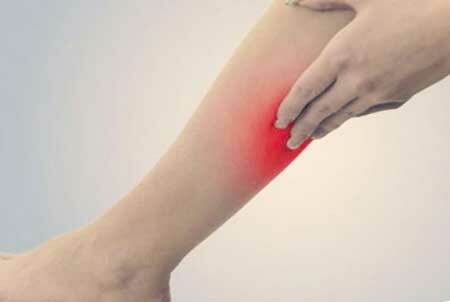
The effectiveness of treatment depends on accurate diagnosis, which includes:
- diagnostic examination by a surgeon;
- examination of the vessels of ultrasound with dopplerometry;
- radiopaque phlebography - examination of the progress of a contrast agent inserted into a vein;
- application of special functional tests, allowing to reveal venous lesions at the earliest stages.
Treatment is caused by an integrated approach that combines medical and surgical techniques.
The method of conservative treatment of thrombophlebitis includes:
- The use of physiotherapy techniques - the introduction of anticoagulants by electrophoresis, hydrotherapy with variable baths, UHF procedures.
- Drugs - anti-inflammatory, anticoagulants for plasma liquefaction, antispasmodics and antibiotics.
- Application of compression linen to prevent vascular enlargement damage to their walls - special bandages, tights and socks for compression of the affected venous walls.
In case of inconsistency of conservative therapy, radical and minimally invasive surgery is used.
- Radical surgical method involves the removal of the affected vein, to prevent the further spread of the pathological process. Today it is used in exceptional cases, with an extensive process that threatens the patient's life.
- Technique of endovasal laser coagulation. As a result of laser treatment of venous walls and thrombotic clot, the vessel is glued, completely removing it from the circulatory process, directing blood along a healthy bed.
- Thrombus removal by endoscopic method. With the help of endoscopic instruments inserted into the vessel, the thrombus is removed and a special trap is installed or the vessel is bandaged.
- Bonding of the affected channel by sclerotherapy - introduction into the vessel of a special composition.
- The method of venous thrombectomy is used for the extraction of thrombotic clots by a special catheter
All these methods are quite effective. Allow patients to return to normal painless life.
Compression underwear with thrombophlebitis
Gold standard for the treatment of thrombosis in pregnancy - compression underwear. Its wearing is due to the effect of squeezing the superficial venous system, causing it to increase pressure, improving venous outflow.
The puffy or stockings of the varicose area will not allow the thrombus to settle in it, which will sharply reduce the risk of inflammatory reactions and the formation of thrombosis.
With the use of compression liner, puffiness and convulsive manifestations are excluded, the legs practically do not get tired and the pregnancy does not become complicated. Pregnant women are recommended:
- specially selected exercises that improve venous outflow;
- long walks;
- for chronic pathology - evening walks for at least half an hour;
- diet is saturated with fruits and vegetables, as they are stimulants of hemodilution( dilution of thickening).
To avoid puffiness, do not use a lot of fluid and drugs that affect the vascular system( phlebotonics).Selection of compression linen with thrombophlebitis should be carried out on the recommendation of a doctor, taking into account the type and degree of compression of products.


